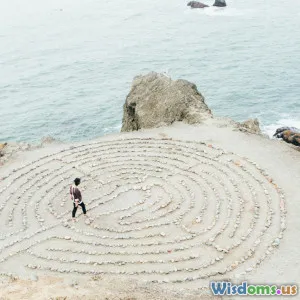
Is True Connection Possible Without Vulnerability in Spirituality
8 min read Explore how vulnerability shapes authentic spiritual connections, revealing the essential role it plays in deepening relationships and personal growth. (0 Reviews)
Is True Connection Possible Without Vulnerability in Spirituality?
Introduction
In the expansive realm of spirituality, the concept of true connection is often heralded as the ultimate goal — a deep, soulful engagement that transcends ordinary interaction and fosters profound unity. Yet, a critical question arises: Can this level of connection exist without the cornerstone of vulnerability? Many spiritual seekers desire authentic bonding, but shy away from exposing their innermost selves due to fear or conditioning. This article delves into the intricate link between vulnerability and authentic connection in spirituality, unlocking why openness and trust are indispensable in forging meaningful spiritual relationships.
Defining True Connection in Spirituality
Spiritual connection goes beyond surface-level interactions; it involves a mutual recognition of soul essence, shared purpose, or collective awakening. Psychological studies emphasize that such connections contribute to improved mental health, resilience, and overall well-being (Holt-Lunstad, 2017).
What Constitutes True Spiritual Connection?
- Authenticity: Engaging genuinely without masks.
- Mutual Compassion: Feeling and responding empathetically.
- Shared Purpose or Values: Alignment in spiritual beliefs or goals.
- Presence: Fully attending to the other without distraction.
For example, consider the ancient practice of "satsang" in Indian spiritual traditions — gatherings where seekers share honestly and vulnerably, creating a fertile space for collective insight and healing.
Understanding Vulnerability in Spiritual Contexts
Vulnerability means opening oneself to potential emotional exposure, uncertainty, and risk. Renowned researcher Brené Brown defines vulnerability as “uncertainty, risk, and emotional exposure,” highlighting its strength rather than weakness.
Why Vulnerability Often Feels Daunting
- Fear of Judgment: Revealing imperfections may invite criticism.
- Cultural Conditioning: Societal norms often discourage emotional openness.
- Personal Trauma: Past vulnerabilities may have been met with harm.
Yet, in spirituality, vulnerability can be transformative — it's the gateway to transcend ego defenses and experience authentic presence.
The Role of Vulnerability in Creating True Spiritual Connections
Breaking Down Barriers
Without vulnerability, interactions may remain superficial. Openness disarms armor, enabling others to see our whole selves — not just curated personas. For example, spiritual communities that foster open sharing often report stronger support networks and healing dynamics.
Facilitating Empathic Resonance
Vulnerability invites empathy. When one reveals struggles or doubts, others relate on a human level, reinforcing collective compassion. Neuroscientific research points to mirror neurons activating during genuine emotional exchanges, fueling connectedness (Iacoboni, 2009).
Enhancing Mutual Growth
Spirituality often entails evolving beyond egoic limitations. Vulnerability creates fertile ground for honest reflections, feedback, and spiritual guidance. A spiritual mentor and student exemplify this: transparency encourages dynamic exchanges, essential for growth.
Can Spiritual Connection Exist Without Vulnerability?
Surface-Level Connection vs. Depth
One might argue that agreements around spiritual concepts can exist without deep vulnerability — such as attending group meditations or synchronizing prayer times. However, this connection tends to be more collective identity than intimate bonding.
Examples:
- Online spiritual forums where members share insights but avoid personal disclosure.
- Religious rituals conducted in formality without sharing emotional truth.
Limitations of Connections Without Vulnerability
Without vulnerability:
- Relationships remain transactional or performative.
- Emotional isolation persists despite communal settings.
- Opportunities for healing and transformation diminish.
A study published in the "Journal of Spirituality in Mental Health" (2020) highlighted that spiritual communities encouraging vulnerable sharing experienced higher cohesion and individual satisfaction.
Integrating Vulnerability into Spiritual Practice: Real-World Insights
Practicing Mindful Vulnerability
Mindfulness and contemplative practices help individuals observe fears around vulnerability without becoming overwhelmed. This awareness fosters courage in sharing authentically.
Creating Safe Spaces in Spiritual Groups
Intentional parameters, such as confidentiality, agreed respect, and nonjudgmental attitudes, nurture vulnerability. For example, Circle processes in indigenous ceremonies create trusting environments for open exchange.
Leveraging Storytelling and Testimonies
Sharing personal journeys, including doubts and failures, connects individuals deeply. Famous spiritual authors like Thich Nhat Hanh and Pema Chödrön openly discuss their struggles, promoting vulnerability as healing.
Challenges to Vulnerability in Spiritual Contexts
- Spiritual Bypassing: Avoiding pain under the guise of spiritual growth suppresses vulnerability.
- Power Dynamics: Imbalanced authority may intimidate open sharing.
- Societal Stereotypes: Masculinity norms, emotional repression, and stigma hinder vulnerability.
Addressing these obstacles is crucial for authentic connection.
Conclusion: The Inseparable Bond of Vulnerability and True Spiritual Connection
True connection in spirituality cannot be fully realized without vulnerability. The depth, empathy, and transformative power essential to spiritual unity arise through the courageous act of opening oneself authentically. Vulnerability dismantles barriers, fosters empathy, and nurtures mutual growth beyond egoic separateness.
As Brené Brown eloquently puts it, “Vulnerability is not winning or losing; it’s having the courage to show up and be seen when we have no control over the outcome.” Spiritual seekers and communities embracing this truth are better equipped to create meaningful, lasting connections that elevate collective consciousness.
In practical terms, spiritual practitioners are encouraged to:
- Cultivate safe environments for honest sharing.
- Practice mindful self-awareness of vulnerabilities.
- Embrace storytelling as a tool for authentic connection.
By integrating vulnerability, spirituality transforms from individual pursuit into a collective journey of deep connection and profound healing.
References
- Brown, B. (2012). Daring Greatly. Gotham Books.
- Holt-Lunstad, J. (2017). The Potential Public Health Relevance of Social Connection and Integration. American Journal of Public Health.
- Iacoboni, M. (2009). Mirroring People. Farrar, Straus and Giroux.
- Journal of Spirituality in Mental Health. (2020). The Impact of Vulnerable Sharing in Spiritual Communities.
This article aims to inspire readers to embrace vulnerability as a path to genuine spiritual intimacy and connection.
Rate the Post
User Reviews
Other posts in Compassion & Loving Kindness
Popular Posts

















